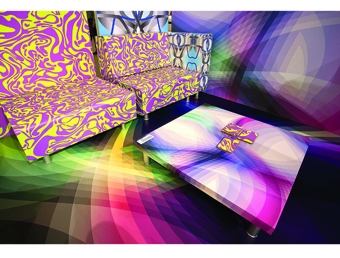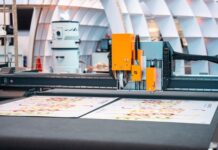Karim Rashid’s industrial design practice encompasses graphics, interior décor, architectural design, and furniture design; as such, the studio needs to respond to a wide range of customer requests for products and samples.
The studio required a fast, easy-to-use method of producing designs for graphics, fabric and furnishings that could handle the growing trend for increased levels of decoration. The company wanted in-house large-format printing capabilities that met its requirements, was easy-to-use, versatile, productive and suitable for an office environment.
When Karim Rashid established his design consultancy in New York City twenty years ago, trends were very different. Since then, keeping up and setting new trends has been a challenge, but Karim Rashid and his team have had several advantages.
“When I opened the company, designers tended to have specific areas of focus,” Karim says. “There were graphic designers, interior designers, industrial designers, fashion designers and architects. It was unusual to find a company that did all those things.”
While Karim Rashid Inc. is primarily an industrial design practice, its work goes well beyond the usual definitions.
“We offer customers a holistic approach,” Karim explains. “I describe it as working from ‘micro to macro.’ That means we do everything from designing small objects, like a perfume bottle, to doing the whole branding concept and logo, providing seamless integration of the design concept.”
Karim’s work extends well beyond that too, embracing graphics, interior design and architecture.
“Historically, the link between design and architecture hasn’t been that common,” Karim says. “However, there are some notable examples. Frank Lloyd Wright was one of the few architects of his period that paid attention to design beyond the building. He designed furniture, carpets, lighting and many other objects to go in his spaces.”
Versatility and Immediacy
In his work, Karim explores new materials and techniques, discovering HP Latex Printing Technologies shortly after their launch. Karim has designed a lot of wallpaper and noticed that his local printers were all using HP equipment, indeed, there was an HP plotter in his office for architectural work. The experience of quality print and reliability made the move to HP Latex Ink easier.
Wallpaper design is print-intensive, so there were many trips to local printers. “I’d have twenty patterns that I’d want samples of and these could be in up to ten different color schemes,” he explains. “One day, I went to get some samples and the printer gave it to me on a real wallpaper substrate. It was amazing to see the design as it would actually be printed. That was my first encounter with HP Latex Printing Technologies.”
Since then, Karim has used HP Latex Printing Technologies for a wide variety of projects including textile and wallpaper printing, and creating distinctive graphics on clear self-adhesive film to decorate mirrors for the bar at Milan’s stylish nhow Hotel.
“In late 2013, we took the decision to bring HP Latex printing in-house,” Karim says. “We installed an HP Latex printer and today we are able to develop our designs faster, more efficiently and cost-effectively.”
Karim and his team have used the printer with a wide range of material, creating samples on final substrates, or something close to it.
“We’ve printed carpets, bath mats, bathrobes, graphics and wallpaper,” he says. “For one client, we showed models on furniture we’d designed in dresses made of Tyvek that we’d designed and printed using our HP Latex printer.”
Karim describes key results of using HP Latex Printing Technologies, “I love its immediacy: we can print a design and see it very quickly and then evaluate the design and make adjustments and print it again,” he explains. “This saves a lot of time and helps us keep our focus on the work.”
“Secondly, because the prints are dry from the printer, we are able to work with them instantly,” he says. “Previously, it used to take a lot of time between the time a design was made and when the designer could see how it looked in reality.
“Thirdly, we can print on a one-to-one scale. When designing wallpaper, for example, in the past because of the time and cost, we’d print scaled down samples for evaluation. Today we can print full-size and give our customers an exact picture of what the job will look like.”
Helping Keep to Schedule
There are eighteen people working at Karim Rashid Inc. It’s a number that Karim finds optimal to handle the volume of work while retaining overall design control.
“We want the company to grow in terms of our ability to do things, but not necessarily in size,” he says. “Our goal is to meet customer expectations by providing the designs and products that are best for their businesses. Often we don’t have much time to achieve that, which is a way of being able to have full control over our printing is so important.”
According to Karim, it is fairly typical to have only ten days between receiving a brief and working up thirty to forty designs.
“When a customer is flying in from Germany to see what we’ve done, it’s great to be able to print and pin up twenty huge sheets for them to see when they walk in,” he says. “The HP Latex printer makes that possible.”
A New Decorative Age
Looking ahead, Karim sees the continuation of the trend in decoration that began five to seven years ago.
“For a long time due to modernism spaces used to be very plain, hard-edged and white,” he says. “Today there’s more color, more texture, more decoration. Carpets, curtains, upholstery and wallpaper are all back with color, pattern, ornamentation, and this movement will flourish even more and more in the future.”
Karim is particularly interested in “infosthetics,” or the use of digital information and data images in decoration. “These images create wonderful opportunities for contemporary design, and HP Latex Printing Technologies reflect many of the same values: immediacy, green, high-tech, and high-quality,” he concludes.
For more information, visit http://hp.com/go/graphicarts.











